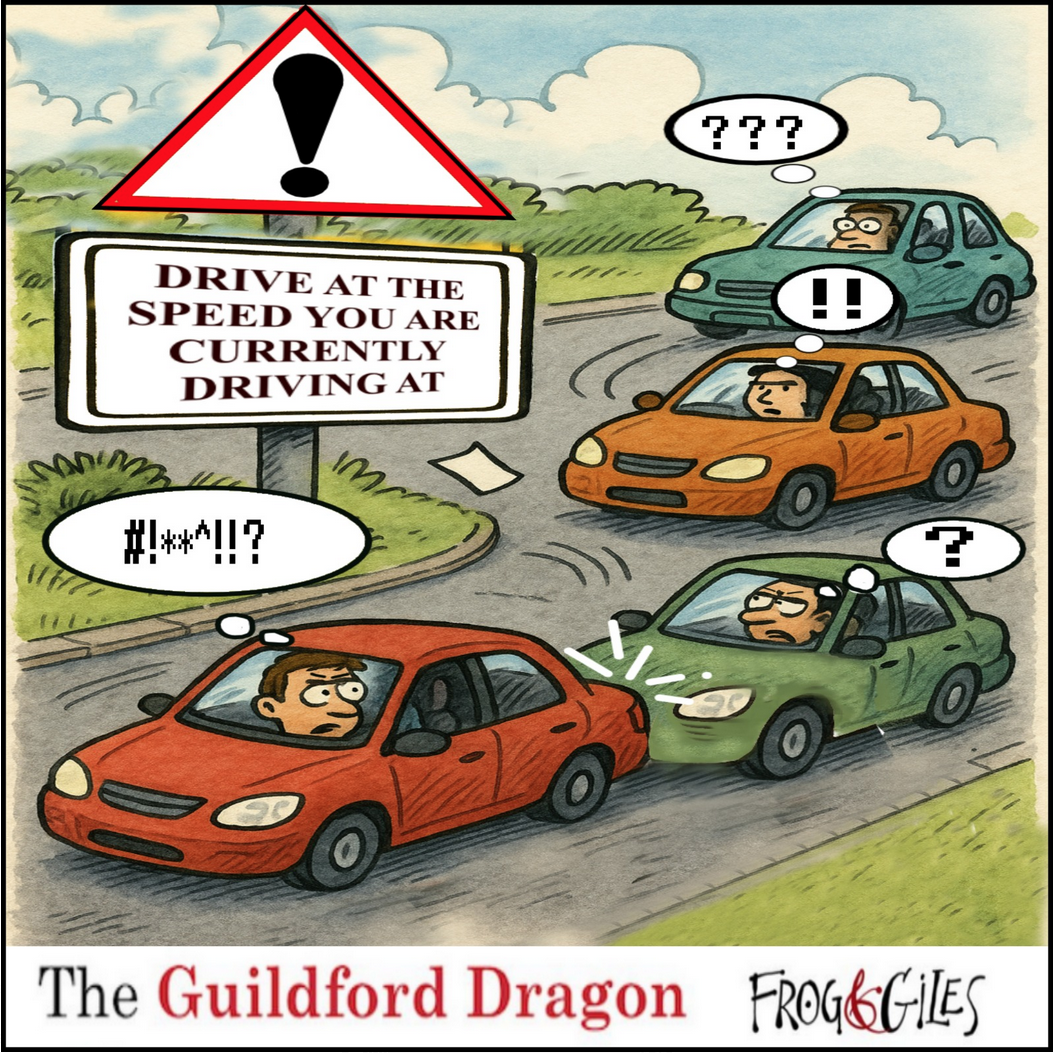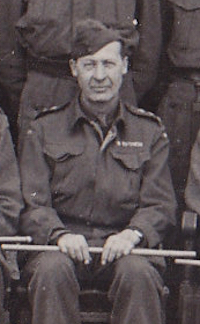 Abraham Lincoln
If given the truth, the people can be depended upon to meet any national crisis...
Abraham Lincoln
If given the truth, the people can be depended upon to meet any national crisis...
 Guildford news...
for Guildford people, brought to you by Guildford reporters - Guildford's own news service
Guildford news...
for Guildford people, brought to you by Guildford reporters - Guildford's own news service
Here’s The Real Dad’s Army With A Famous Illustrator Among Them!
Published on: 30 Jan, 2016
Updated on: 30 Jan, 2016
By David Rose
With a new feature film adaptation of the classic BBC TV comedy series Dad’s Army set to be shown in cinemas from the end of next week (February 5), here’s the real thing – men from Merrow’s Home Guard pictured sometime between 1942-44.

Home Guards pictured in front of the clubhouse at Guildford Golf Club. Pictures courtesy of Jan Welsman. Click on picture enlarge in a new window.
These two photos were emailed to me by Jan Welsman, whose grandfather Harry Ruddock is pictured. They are gathered in front of the clubhouse of Guildford Golf Club at the top of High Path Road, Merrow.

A second slightly different photo of the men who patrolled the Merrow area. Click on picture to enlarge in a new window.
Jan read the Parke’s People story published on The Guildford Dragon NEWS a while ago about artist E. H. Shepard (illustrator of A. A. Milne’s Winnie the Pooh books) in which Bernard noted that Shepard was second in command of “B” Company of the Guildford Home Guard, and was responsible for the Merrow and the downs area in his adopted town of Guildford.
Looking at these pictures and knowing that her grandfather was in the Home Guard in Merrow she believes she has indentified Ernest Shepard in each one.
I am sure she is right. However, I asked historian friend of mine Frank Philipson to see if he could add some details. To begin with, he has found a Pathe News film of Ernest Howard Shepard that was shot at Shepard’s home in 1946. Click here to view it on You Tube.
You will see the likness to the man in the Home Guard pictures.
It is believed therefore that the Home Guards are from the 4th (Guildford) Battalion Surrey Home Guard’s “B” Company.
Its company commander was Colonel C. R. Wigan, who lived in Londown Road, (off One Tre Hill) at a house called Farthings.
Second in command of the company was Shepard, whose rank was captain. The men were neighbours as Shepard lived at Long Meadow in Longdown Road.
Frank’s reserch leads him to believe the two photos were taken in either 1942-43, when the battalion had become established and all had battledress, or more likely in about 1944 before the Home Guard was disbanded.
Frank has counted the men in the photos. One has 102 men pictured the other 98. He suggests that it may show numbers 6 and 7 Platoons, of which Captain Shepard was the commander.
“B” Company consisted of: No.4 Platoon – Stoke, Stoke Park and the River Wey; No.5 Platoon – Burpham including Abbotswood and up to the Effingham Junction railway line; No. 6 and 7 Platoons – Merrow and the downs.
The HQ for No.6 and 7 Platoons was a house called Whiteways in White Lane. This house’s outbuildings was where an Avro Anson crashed when it failed to take off from the Merrow landing ground on January 17, 1941.
Read Frank’s story about the landing ground previously published on The Guildford Dragon NEWS.
Frank says it is difficult to establish exactly how many men were in No.6 & 7 Platoons or “B” Company. At one point it seems that “B” Company had around 200 men– this may have been early on during the Second World War.
He adds that by 1943 the 4th (Guildford) Battalion Surrey Home Guard had reached a maximum other ranks strength of 3,200. If you divide that by the seven companies and leaving some of that number (200) in HQ, transport positions etc., you get a figure of about 425 men in each company!
Two interesting events are noted in the book The Guildford Home Guard, written and published after the war by its commanding officer Colonel G. W. Geddes (and long out of print):
July 18th 1943 – 34 members of “E” Company “represent German paratroops” in an “attack” on Chilworth station and “destroy” the (foot) bridge, the signal box and sidings before local HG even aware of it.
July 22nd 1944 – exercise with US Paratroops acting as the enemy. They were “….ably guided by Quisling officers of the Battalion”.
Jan Welsman has added some details about her grandfather.
Born January, 28, 1894 in Belvedere, Dartford, Kent, Harry Ruddock’s family lived in Shamley Green and he was christianed there on May 6, 1894.
One of nine children, his father was a head gardener and the family lived in a tied cottage in Stroud Lane, Shamley Green opposite from a house called Winters Grace that Alfred Hitchcock lived in from 1928.
Harry was employed as a grocery assistant with the Co-op in local shops around Guildford. He worked his way up to manager of the Co-op in Great Bookham when he was aged 42. He ended his career at the Co-op in Madrid Road, Guildford Park, where he retired aged 65.
His career was interrupted at the aged of 21 by the First World War. He joined up in June 1915 as a signalman in RGA 116 Siege Battery and then 119 Siege Battery. During this time his relationship with his future wife continued by letter.
He left the army in 1919 and married his long-term sweetheart, Florence, on November 6, 1920. His sister, Louisa Corps, found them a house they could rent and move into straight away in the same road she lived in, Down Road, Merrow; which he lived in until the end of his life in June 1965 aged 71.
Harry also enjoyed playing cricket and golf and became captain of his golf team in 1949.
Scriptwriters Jimmy Croft and David Perry of the original TV series Dad’s Army certainly had an eye for detail in the characters they created. I guess one thing they didn’t have in the Walmington-On-Sea platoon was a world renowned artist!
Just what the new film will be like, we shall have to see.
Thanks go to Jan Welsman for sharing the photos and to Frank Phillipson who never fails me when I ask him to do some ‘digging’ on a history topic.

Click on cartoon for Dragon story: Public Asked for Views on SCC’s Proposal for Reduced Speed Limits



Recent Articles
- Lib Dems Easily Hold Three Council Seats in Surrey By-elections
- UK Students to Launch International Space Mission
- New Skate Park Proposed for Cranleigh
- Retrofit Planned for Guildford Office Building
- Museum Shines a Light on Victorian Send, Ripley and Pyrford
- Guildford Festival Burst with Colour, Culture and Community Spirit
- Conservationists Celebrate Victory As Fast-food Plan At Nature Reserve Is Turned Down
- Incident in High Street – Man Found Unresponsive
- Letter: The Weyside Scheme Is Not Going To Be GBC’s Woking
- Guildford’s First “Bike Bus”


Search in Site
Media Gallery
Dragon Interview: Local Artist Leaves Her Mark At One of England’s Most Historic Buildings
January 21, 2023 / No Comment / Read MoreDragon Interview: Lib Dem Planning Chair: ‘Current Policy Doesn’t Work for Local People’
January 19, 2023 / No Comment / Read MoreA3 Tunnel in Guildford ‘Necessary’ for New Homes, Says Guildford’s MP
January 10, 2023 / No Comment / Read More‘Madness’ for London Road Scheme to Go Ahead Against ‘Huge Opposition’, Says SCC Leader
January 6, 2023 / No Comment / Read MoreCouncillor’s Son Starts Campaign for More Consultation on North Street Plan
December 30, 2022 / No Comment / Read MoreCounty Council Climbs Down Over London Road Works – Further ‘Engagement’ Period Announced
December 14, 2022 / No Comment / Read MoreDragon Interview: GBC Reaction to the Government’s Expected Decision to Relax Housing Targets
December 7, 2022 / No Comment / Read MoreHow Can Our Town Centre Businesses Recover? Watch the Shop Front Debate
May 18, 2020 / No Comment / Read More








Recent Comments